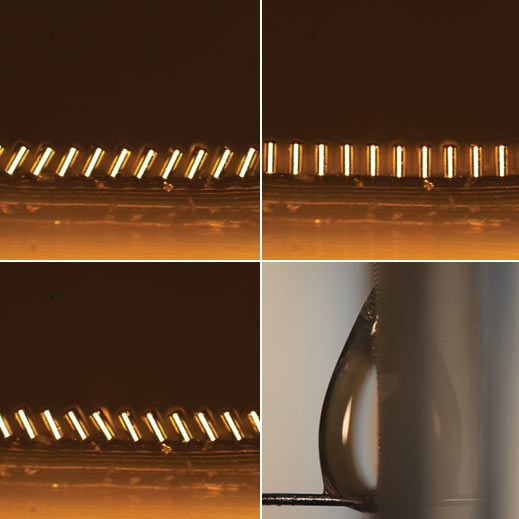MIT engineers have fabricated an elastic material coated with microscopic, hairlike structures that bend in response to a magnetic field. Depending on the field’s orientation, the hairs tilt to form a path through which fluid can flow; the material can even direct water upward, against gravity.

In experiments, the magnetically activated material directed not just the flow of fluid, but also light—much as window blinds tilt to filter the sun. Researchers Evelyn Wang ’00, an associate professor of mechanical engineering, and graduate student Yangying Zhu, SM ’13, say the work could lead to waterproofing and antiglare applications, such as “smart windows” for buildings and cars. The material, which they described in Advanced Materials, could also be embedded in lab-on-a-chip devices to direct the flow of cells.
The inspiration for the array comes partly from nature. The researchers sought to engineer a responsive material that mimics the motion of cilia, small hairs that line human nasal passages and sway back and forth to remove dust and other particles.
Each micro-hair, made of nickel, is about 70 microns high and 25 microns wide—about one-fourth the diameter of a human hair. To create an array of the micro-hairs, the researchers electroplated custom molds with nickel and stripped away the molds. They then bonded the resulting nickel pillars to an elastic, transparent layer of silicone. By placing the material between two large magnets, they can control the angle and direction of the pillars, which tilt toward the angle of the magnetic field. When the magnetic field switches direction, the fluid instantaneously changes direction as well.
In principle, more complex magnetic fields could be designed to create intricate tilting patterns throughout an array. Since the material is flexible, Wang says that it may even be woven into fabric to create rain-resistant clothing.
“You can attach it to something with interesting contours,” Wang says. “Or, depending on how you design the magnetic field, you could get the pillars to close in like a flower. You could do a lot of things with the same platform.”
Keep Reading
Most Popular
Large language models can do jaw-dropping things. But nobody knows exactly why.
And that's a problem. Figuring it out is one of the biggest scientific puzzles of our time and a crucial step towards controlling more powerful future models.
How scientists traced a mysterious covid case back to six toilets
When wastewater surveillance turns into a hunt for a single infected individual, the ethics get tricky.
The problem with plug-in hybrids? Their drivers.
Plug-in hybrids are often sold as a transition to EVs, but new data from Europe shows we’re still underestimating the emissions they produce.
Stay connected
Get the latest updates from
MIT Technology Review
Discover special offers, top stories, upcoming events, and more.